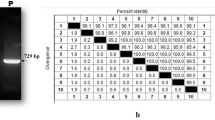Abstract
Trichinella parasites with different epidemiological features still occur in Europe and four species of genus Trichinella have been identified: T. spiralis, T. britovi , T. nativa and T. pseudospiralis. Until now, two of them, T. spiralis and T. britovi, have been identified in Poland. In our studies we selected sequence coding for large mitochondrial rRNA (mt LrDNA) as a genetic marker and developed a sensitive LrDNA multiprimer PCR assay allowing for rapid identification of T. spiralis and T. britovi, parasites present in wild and domestic animals in Poland.



Similar content being viewed by others
References
Bandi C, La Rosa G, Bardin MG, Damiani G, Comincini L, Tasciotti L, Pozio E (1995) Random amplified polymorphic DNA fingerprints of the eight taxa of Trichinella and their comparison with allozyme analysis. Parasitology 110:401–407
Cabaj W, Przyjałkowski Z (1987) Biological characteristics of Trichinella spiralis and T. pseudospiralis infections in mice. Acta Parasitol Pol 32:195–204
Cabaj W, Pozio E, Moskwa B, Malczewski A (2000) Trichinella britovi and T. spiralis in red foxes ( Vulpes vulpes) in Poland. Acta Parasitol 45:340–344
Dupouy-Camet J, Robert F, Guillou JP, Vallet C, Perret C, Soule C (1994) Identyfication of Trichinella isolates with random amplified polymorphic DNA markers. Parasitol Res 80:358–60
Gasser RB, Zhu X, Monti JR, Dou L, Cai X, Pozio E (1998) PCR-SSCP of RDNA for the identification of Trichinella isolates from mainland China. Mol Cell Probes 12:27–34
Nagano I, Wu Z, Matsuo A, Pozio E, Takahashi Y (1999) Identification of Trichinella isolates by polymerase chain reaction-restriction fragment length polymorphism of the mitochondrial cytochrome c-oxidase subunit I gene. Int J Parasitol 29:1113–1120
Nowosad P, Pozio E (1998) First report of Trichinella britovi in wildlife from Poland. Acta Parasitol 43:236–237
Thompson JD, Gibson TJ, Plewniak F, Jeanmougin F, Higgins DG (1997) CLUSTAL X Windows interface: flexible strategies for multiple sequence alignment aided by quality analysis tool. Nucleic Acids Res 24:4876–4882
Wu Z, Nagano I, Pozio E, Takahashi Y (1999) Polymerase chain reaction-restriction fragment length polymorphism (PCR-RFLP) for the identification of Trichinella isolates. Parasitology 118:211–218
Zarlenga DS, Chute MB, Martin A, Kapel CMO (1999) A multiplex PCR for unequivocal differentiation of encapsulated and non-encapsulated genotypes of Trichinella. Int J Parasitol 29:1859–1867
Acknowledgement
This work was supported by research grant no. 6 P04C 02218 from the State Committee for Scientific Research, Warsaw.
Author information
Authors and Affiliations
Corresponding author
Rights and permissions
About this article
Cite this article
Borsuk, P., Moskwa, B., Pastusiak, K. et al. Molecular identification of Trichinella spiralis and Trichinella britovi by diagnostic multiprimer large mitochondrial rRNA amplification. Parasitol Res 91, 374–377 (2003). https://doi.org/10.1007/s00436-003-0971-x
Received:
Accepted:
Published:
Issue Date:
DOI: https://doi.org/10.1007/s00436-003-0971-x




